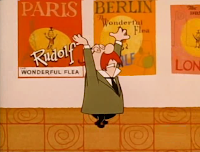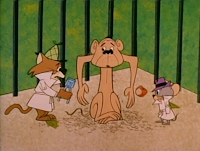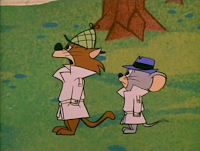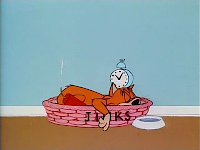Yowp note: The music in this post is NOT public domain and is provided as a public service for audition purposes only.Music evokes memories. Music in cartoons included. Play Raymond Scott’s Powerhouse for someone and see if they can Name That Bunny in four notes.
The music of the Hanna-Barbera TV cartoons is no different, despite being originally designed to linger in the background while setting moods for TV westerns and sitcoms, industrial films and low-budget movies. But because the composers were so adept, the music not only does its utilitarian job, it sticks in people’s minds (especially after endless viewings of the cartoons).
If I had to name a melody that epitomises the early H-B cartoons, I’d have to actually name two. It’s difficult to picture Yogi Bear in action without hearing the tippy-toe xylophone and laughing clarinet of ‘Zany Comedy’, credited to Bill Loose and John Seely. The other instantly conjures the sight of Pixie and Dixie running past the same wall socket for the eighth time—‘Toboggan Run’, credited to Jack Shaindlin.
While Loose and Seely were the masterminds behind the Capitol Hi-Q library, whence Hanna-Barbera found much of its music, Shaindlin was the man responsible for the other library, Langlois Filmusic, which also made its merry way into countless Huck, Yogi and Quick Draw escapades. Not coincidentally, it was distributed by Capitol.
Shaindlin’s story is a little less complicated than that of his library. According to Music and Dance in New York State, edited by Sigmund Gottfried Spaeth, Shaindlin was born April 14, 1909 in Russia. He attended the Crimea Conservatory of Music and then studied piano privately with Glenn Dillard Gunn in Chicago. The International Motion Picture Almanac (1948 edition) further reveals he went to high school in Chicago, then the Chicago Conservatory of Music; from 1926 to 1929 he was the conductor of the N.Y.U. Orchestra and conducted orchestras at movie houses; worked as a scorer for RKO and Universal from 1929 to 1936; was Director of Music for Columbia and Universal (eastern productions) in 1937, then moved on to The March of Time in 1941. It also mentions (unlike later editions) he produced musical shorts and operated a musical scoring service from the Fox Movietone offices in New York.
The book Conductors and Composers of Popular Orchestral Music by Naomi Musiker and David Adès, page 244, adds the following:
Shaindlin was born in Yalta but moved to America after the Russian Revolution. Shortly after landing in America, he won first prize in a newspaper-sponsored piano contest. He began his professional career by playing piano in small clubs and landed his first movie job at the age of sixteen, playing an organ at a theater. At the age of eighteen he joined a large orchestra and became a conductor. He subsequently performed at the Palace Theatre playing the piano, writing and acting in skits.
At the age of twenty-two, he started working for Universal Pictures and thereafter for RKO, Columbia and Louis DeRochemont as well as a twelve-year association with OWI films as musical director. In 1947 and 1948, he received critical acclaim for his conducting of pops symphony concerts at Carnegie Hall. He also lectured on movie music and was associated with the Ford Foundation’s television series. He was credited with the music of films such as
Lost Boundaries, Teresa and
Cinerama Holiday.
This only hints at Shaindlin’s involvement in the music library business. Stock music expert Paul Mandell, in a chapter of a book published by the U.S. Library of Congress, reveals:Shaindlin (1909-1983) began scoring the March of Time newsreels [released by RKO] in 1942 and served as music director of Fox Movietone News in New York. Around 1950, Shaindlin and his composer-partner Robert McBride organized their news-reel and documentary tracks and started Filmusic, “the largest sound-on-film library in the US with over 2000 moods for dramatic, news, and comedy films.”
As a side-note, Shaindlin replaced Lou De Francesco on The March of Time. De Francesco wrote music for the Sam Fox library and one of his cues, Ski(ing) Galop, was used in some of the first Huck and Yogi cartoons. Before McBride arrived in 1945, Shaindlin worked with Ernest Fiorito, another composer for Sam Fox.
With all the music Shaindlin and McBride composed for newsreels for three studios (including the Bill Stern World of Sports one-reelers at Columbia) and the De Rochemont shorts, they had a ready-made library.
We now have to back up for a second and make a side-trip along the path of old time radio. A couple of guys, Cyril Langlois, Sr. and radio announcer Ralph Wentworth, branched out from the radio ad agency business in 1935 to create Lang-Worth Feature Programs, Inc., which supplied radio shows and music on transcription. Wentworth sold out to Langlois in 1942 and the business carried on. Among the orchestra leaders who supplied musical material for Lang-Worth in the later ‘40s was Jack Shaindlin. It was perhaps inevitable the two joined forces in the library music business.
Business Screen Magazine in 1954 unveiled the big announcement:Formation of Langlois Filmusic, Inc.
Provides a Major Music SourceThe combined music scoring facilities and all sound track of FILMUSIC Company and LANG-WORTH Publications, Inc. have been merged under the new name of LANGLOIS FILMUSIC, Inc., with headquarters in the Warner Brothers Bldg., 619 West 5th Street, New York 19.

The merger of two of the largest companies in the field of picture scoring makes available a service to film producers that provides the largest library of sound track in the world, produced specifically for television, theatrical, industrial and sound slidefilm use.
Jack Shaindlin, formerly operator of Filmusic Company, has withdrawn from active participation in picture scoring from library track to devote himself to original scoring with "live" musicians [Shaindlin became a live-action producer as production head of Triumph Films on West 54th in New York, with McBride as his musical director]. He has turned over all customer accounts and facilities to Langlois Filmusic, Inc. Mr. Shaindlin will continue to serve the new corporation in an advisory capacity for "live" picture scoring.
Jumping off to a fast start, Langlois Filmusic furnished music scores for over five hundred film productions, including business motion pictures, t.v. films and commercials and slidefilms during its first month of operation in January.
This was the library that was tracked by Hanna-Barbera for the Huckleberry Hound and Quick Draw McGraw shows—and by syndicators such as ZIV.
Paul Mandell’s meticulous research explains more about Langlois Filmusic:The fanfare for the “torch lady” logo at the end of every Screen Gems television show was a celebrated piece from this collection.
What made the library famous were the sneak-alongs with spooky clarinets and brass stingers used in
Mr. And Mrs. North, Boston Blackie, Science Fiction Theatre and the final year of
Superman. “In Cold Blood,” “Closing In,” “Crime Lab,” “Manhunt,” and “Sweating It Out” were typical cue titles. McBride wrote most of them and Shaindlin orchestrated them. They were shrewdly crafted works, remarkable for their economy, with repeated pauses and abrupt hits to facilitate the seemless editing of one with the other.
As Shaindlin's key tracker Frank Lewin observed, “Jack never wrote anything himself. He always had a stable of writers working for him.” Among them were Louis Applebaum, Rick DuPage, George Chase, Lan Adomian, and German composer Richard Mohaupt. Charles Strouse of Annie and
Bye Bye Birdie fame ghostwrote much of Shaindlin’s show music. Even Morton Gould lent a helping hand with the light comedy cue “Toboggan Run.”
Mandell’s research shows Langlois Filmusic folded about 1960, though industry catalogues still list it into the ‘60s. But this didn’t end Shaindlin’s involvement in the library music business. Somehow, he maintained or retrieved the rights to his old music and in 1965, Cinemusic was born (though trade ads insist it was founded in 1949; that may be the year of Shaindlin’s original company).  He began to repackage—and occasionally re-record, it seems—some of the Langlois library. 20 LPs containing 385 cues of different lengths in 34 moods were advertised in 1965, with a second set in 1966 and a third in 1968. Further volumes followed with a more up-to-date sound than some of the themes designed for fashion shows, sports contests and war footage on newsreels.
He began to repackage—and occasionally re-record, it seems—some of the Langlois library. 20 LPs containing 385 cues of different lengths in 34 moods were advertised in 1965, with a second set in 1966 and a third in 1968. Further volumes followed with a more up-to-date sound than some of the themes designed for fashion shows, sports contests and war footage on newsreels.
Now, let’s take a listen to some of the Shaindlin music that you’ve no doubt heard behind the Yogi, Huck and the Meeces. This is not, alas, The Compleat Cartoon Shaindlin. I have about another half-dozen music beds which are unidentified and, frankly, I don’t have the permission of the person who sent them to me to post them. But they don’t represent all of Shaindlin’s work on cartoons, either; there are cues I simply don’t have. What you can hear in this first batch comes from three different sources and the last two cues are not great in quality.
Langlois Filmusic provided cues on film (hence “filmusic”) and on 78s. Click on the title and whatever you use to play MP3s on your computer should pop up.MAD RUSH No. 1MAD RUSH No. 2MAD RUSH No. 3UNTITLED TUNEEXCITEMENT UNDER DIALOGUEASININECAPERSPIXIE PRANKSFUN ON ICECRAZY GOOFFISHY STORYGROTESQUE No 2COMEDY SUSPENSETOBOGGAN RUNRODEO DAYRECESSBecause I promised this post so long ago, I will try to make it up to Jack Shaindlin fans with some bonus Langlois tracks. These were not used by Hanna-Barbera but I know at least a couple were in industrial cartoons produced by John Sutherland.CHILDREN’S SCAMPERTHOROUGHFARELIGHT ‘N’ AIRYMOTOR BOATINGMILD ACTIVITYWALKING BRISKLYHARDWAREFinally, I’m going to leave you with a little story about Jack Shaindlin. This is from the book The Art of Writing Music by John Cacavas and Steve Kaplan. Cacavas was, among other talents, a composer for the Sam Fox library.About proofing music....
I remember one time at a recording session in New York, the well-known film conductor Jack Shaindlin was recording Morton Gould’s score to Windjammer for the soundtrack album. I had been working for Gould as an orchestrator at that time, so I went along with Morton to the studio. This was in the early 1960s, when stereo was in its infancy, and the sound coming from the orchestra was glorious. During a break in the recording, a woodwind player raised his hand and shouted, “Hey Jack, I gotta wrong note in bar 46.”
“Well, play the right one, for God’s sake!” shouted Shaindlin in response.
The first and last screen caps are from a kinescope of an appearance on The Wendy Barrie Show where Shaindlin received the 1956 Clef Award for his work on Cinerama Holiday. The middle one is from the mid-1950s game show Make the Connection hosted by Gene Rayburn.
Jack Shaindlin died in New York on September 22, 1978.
 I can’t explain why I like the Ed Benedict-inspired characters here and the attractive way they’re set up with different sizes and angles. But Will can. And does. Check out his blog post here.
I can’t explain why I like the Ed Benedict-inspired characters here and the attractive way they’re set up with different sizes and angles. But Will can. And does. Check out his blog post here. Joe always has something that interests me on his show, whether it’s old Daws Butler records or (like last week) an interview with puppeteer Craig Marin, who told a wonderful story that everyone can identify with about how he met his TV heroes. Joe also plays soundtracks of old Hanna-Barbera (and other) cartoons. Hear for yourself if Chuck Jones was right to call them “illustrated radio” (Chuck’s description brings to mind that “shoeleather” synonym of Beaky’s). Joe does a show once a week and it plays Monday through Sunday to enable you to catch it. Oh, and Joe has them archived, too. Click here for Joe’s site and you can go to Shokus here.
Joe always has something that interests me on his show, whether it’s old Daws Butler records or (like last week) an interview with puppeteer Craig Marin, who told a wonderful story that everyone can identify with about how he met his TV heroes. Joe also plays soundtracks of old Hanna-Barbera (and other) cartoons. Hear for yourself if Chuck Jones was right to call them “illustrated radio” (Chuck’s description brings to mind that “shoeleather” synonym of Beaky’s). Joe does a show once a week and it plays Monday through Sunday to enable you to catch it. Oh, and Joe has them archived, too. Click here for Joe’s site and you can go to Shokus here. I’d like to thank Joe for asking me to be on his programme and the other very nice people out there I’ve never met who have linked to this blog. I’m not deliberately snubbing anyone by not reciprocating with a widget full of URLs. It’s just one of those things I just have to get around to doing, though I admit I don’t know what sites point you to this one. But I humbly appreciate it, along with all the comments left here by animators, voice actors, fans and experts. I’m still hoping someone out there has more of the stock music used in these cartoons they can pass along or identify, and that there’s someone who can help fill in blanks I have with some old newspaper stories.
I’d like to thank Joe for asking me to be on his programme and the other very nice people out there I’ve never met who have linked to this blog. I’m not deliberately snubbing anyone by not reciprocating with a widget full of URLs. It’s just one of those things I just have to get around to doing, though I admit I don’t know what sites point you to this one. But I humbly appreciate it, along with all the comments left here by animators, voice actors, fans and experts. I’m still hoping someone out there has more of the stock music used in these cartoons they can pass along or identify, and that there’s someone who can help fill in blanks I have with some old newspaper stories.



















































